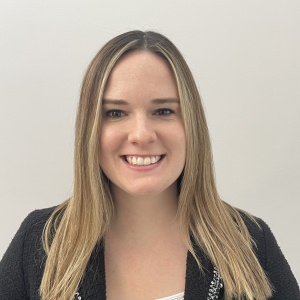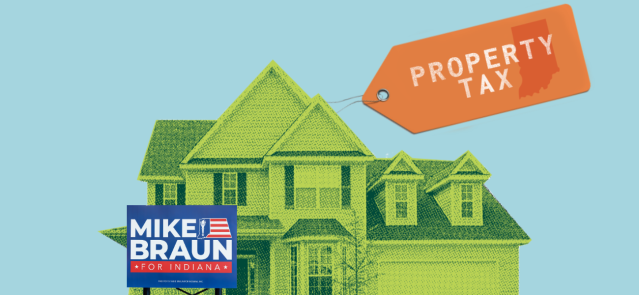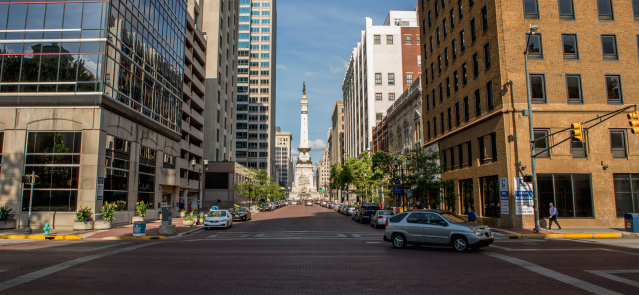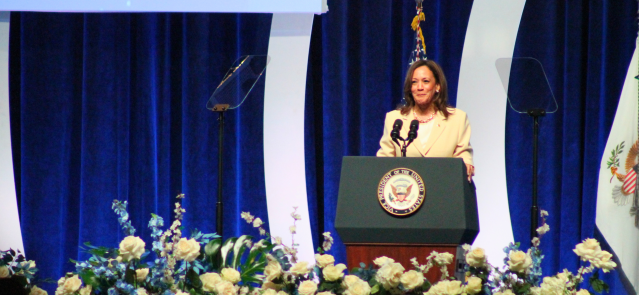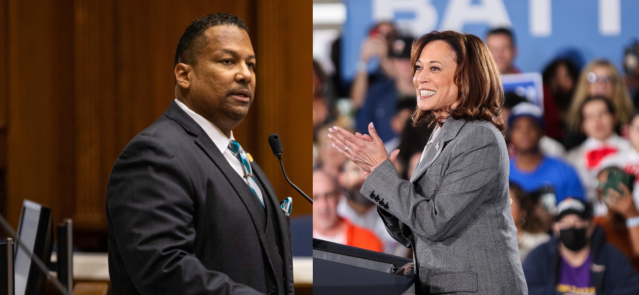Stay ahead of the curve as a political insider with deep policy analysis, daily briefings and policy-shaping tools.
Request a DemoHigher education head Chris Lowery on what’s behind the low college-going rate and how to fix it
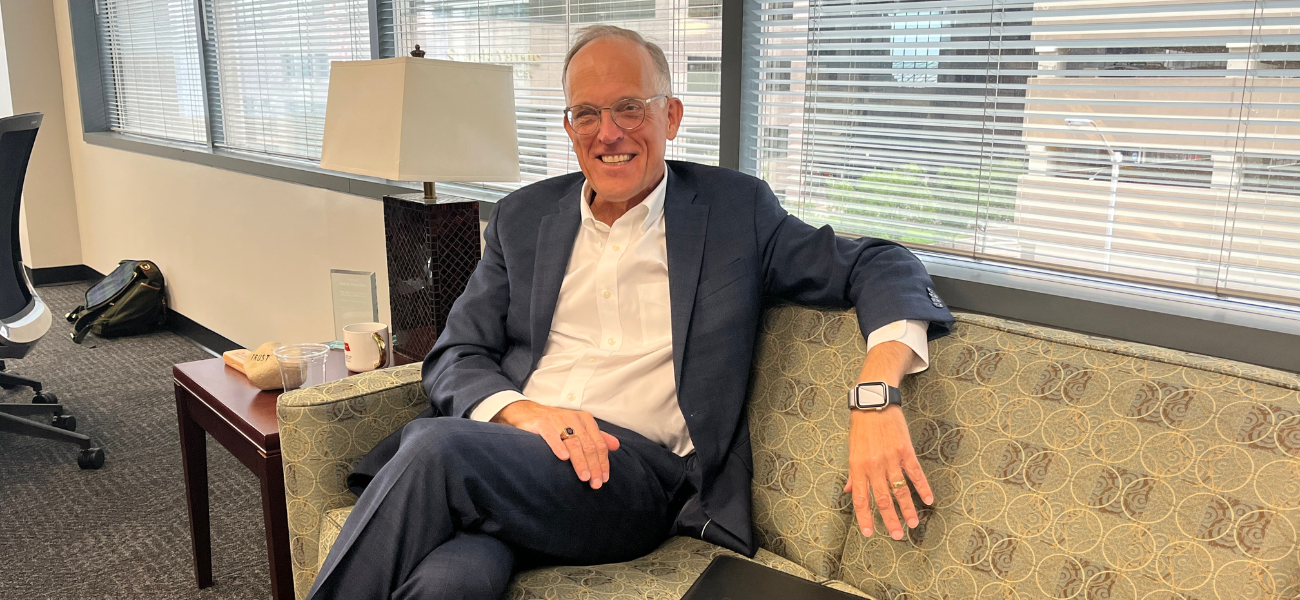
Indiana Commissioner for Higher Education Chris Lowery meets with a reporter on July 26, 2023. (Credit: Kaitlin Lange)
When Chris Lowery stepped into his role as the new commissioner of higher education in March of 2022, he had his work cut out for him. Indiana’s college-going rate was dropping every year when Lowery agreed to lead the Indiana Commission for Higher Education.
“Let’s not admire the problem,” he likes to say. “Let’s do something about it.”
The commission will release its annual College Readiness Report in the coming weeks, but Lowery has already shared the main takeaway: Still fewer Hoosiers are choosing to go to college. But, more than a year into his gig, Lowery, a former Ivy Tech administrator who oversaw the community college’s workforce initiatives, is optimistic change is on the way.
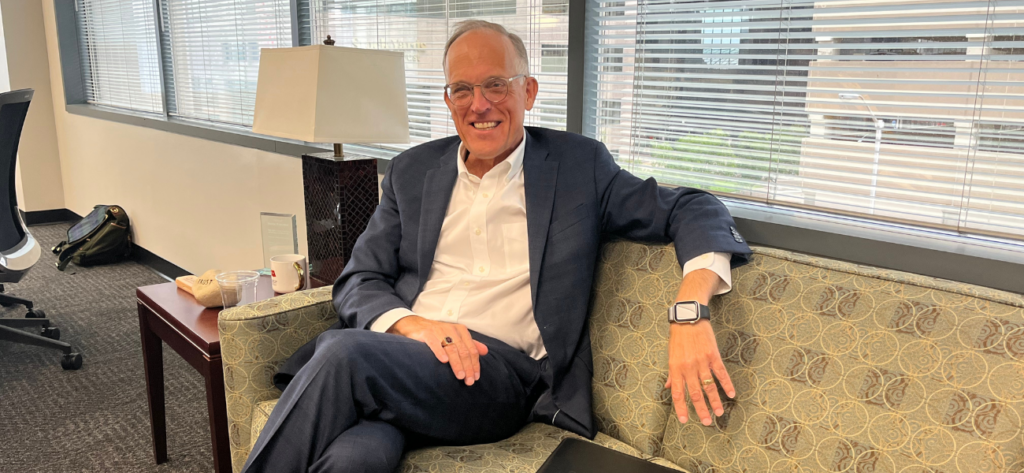
State Affairs spent an hour with Lowery talking about what’s keeping more Hoosiers from attending college and the major changes lawmakers approved regarding higher education this past legislative session.
The conversation has been edited for clarity, brevity and length.
Q. How did you land in this role?
A. Some time ago, I had breakfast with my longtime friend, [then Indiana Commissioner for Higher Education] Teresa Lubbers. She told me she was going to be stepping away, not retiring. [She] kind of hinted, “Hey, you ought to think about it, Chris.” I said, “Well, if somebody calls, I’ll think about it.’ The rest is history, as they say.
It just felt right at the time. It’s funny, Teresa and I both read Arthur Brooks’ book “From Strength to Strength.” It’s very much about what you do with the second half of your life. I was going to be turning 60 when they were starting to recruit me. I don’t know what retirement means.
I gave a lot of thought to it because again, I was doing something I just loved to do. But then also I thought there were more things we could do in Indiana. [We should improve] the college-going rate. People say what do you lose sleep over? I lose sleep over that. And our [college] completion rates, they’ve improved, but they’re not good enough.
The governor and I’ve joked about this portion before: graduate retention. I said, “Do you think they could put up roadblocks in May after college graduation?” That’s probably a little too far. [Indiana State Police] Superintendent [Doug] Carter probably wouldn’t approve of that. But here we are 14th best in the nation at attracting people to our public and private universities, but we’re 40th at retaining our grads. So let’s close that gap.
There was something that brought students here, one of our institutions, one of the programs. Most students really like, oftentimes they loved, their collegiate experience. So how can we parlay that to keeping more of our graduates here in the state short of roadblocks and things like that? But, being more intentional about partnering with businesses to really let graduates know, ‘Hey, we want you here.’
Q. Why should the average Hoosier care about college attainment in Indiana?
A. I absolutely love that question. Educational attainment is ultimately about individual social and economic mobility and prosperity, and the numbers back it up. The degree to which someone has mobility during their life to see improvement in economic condition, social condition, and then to, by their own definition, have prosperity, [usually depends on educational attainment.]
In Indiana for someone with less than a high school diploma, the unemployment rate is [more than] twice as high as it is for folks with a bachelor’s degree and higher. Indiana’s labor participation rate is 63 or 64% today, just a little higher than the national average. The difference between less than a high school diploma and a bachelor’s and higher is 28 points. That’s stunning.
The median wage from a high school diploma to a bachelor’s and higher — the difference 84%. Wow. Roughly [$40,000] to $72,000.
But then also on social outcomes, there are a whole host [of differences]. Not surprisingly, utilization of social assistance benefits [is impacted]. Imagine this: Smaller percentages as you go up the attainment level require [assistance] because they participate in the labor market and make better wages and have greater job security.
Infant mortality, that’s a challenge in our state, and in certainly others. [That’s] two times higher in a household of — again, these are averages, this is not to cast anything on any individual — but twice as high for a high school diploma or less than a bachelor’s degree and higher for a host of reasons: the ability to have a better job, better pay, better health benefits, not live in a food desert, not live in an exercise desert, all those things.
I am always really super careful never to cast aspersions on anyone. I have friends who literally are like the millionaire next door who didn’t go beyond high school. They started a business, very successful, have employed a lot of people, and that’s amazing. But for the average person the opportunities become multiplied [due to education]. The good things increase, the less good things decrease and literally, you can measure it in terms of economic and social outcomes.
Q. The college-going rate is continuing to decline. What’s causing that?
A. As with most policies and strategies and so forth, there’s reality, and there’s also perception, and you have to address both. Affordability, quality and career relevance broadly across the nation are things folks who are considering post-secondary training and education have on their mind.
Can I afford to do it? Or, ‘Hey, I read this in The Wall Street Journal or The New York Times that if you go to college, it’s going to cost a fortune and you’re going to have a quarter million dollars in debt, and you won’t be able to get a part time job.’ Well, that happens, but that’s the unicorn as I’ve been referring to it, but we have to address it.
What are my opportunities to improve economically and socially, in my own life? Again, that data that I was mentioning a few moments ago, we just haven’t been talking about that. Why on earth don’t we make clear to folks that, yes, there’s an investment of funding and time to go do this, but the outcomes, generally speaking, are really good.
On the affordability side of it, of Indiana’s public institutions, Purdue gets a lot of credit and should because under [former] President [Mitch] Daniels, they held the line on tuition and fees that are applicable to all students. But our other institutions did, too. In the last decade, Indiana’s public institutions are sixth best in the nation in holding down tuition and fees. Nobody has really been talking about it. Hoosiers should know that.
By the way, when you adjust it for inflation, even before this increase in inflation last year, our tuition and fees [decreased]. That’s pretty amazing.
We’ve got to work to keep the cost down, but we’ve got to do a better job of letting Hoosiers know actually, we have really good institutions, and a good value.
The other thing is we are first in the Midwest, fifth in the nation, for need-based financial aid. We are a generous state when it comes to need-based financial aid. 21st Century Scholars Program, Frank O’Bannon, Workforce Ready Grants and so forth, and we’ve got to start talking about it.
Now, we’ve got to be vigilant and keep the pressure on. Let’s keep it affordable. Like this year with 21st Century, it was around 32 years, and we said, ‘It’s great, we can’t reach enough kids, let’s make it auto-enroll.’ It passed with bipartisan support, with maybe a stray vote here or there that didn’t go for it, because we said here’s the payoff.
I think we also have to recognize that reaching people takes an effort that’s broader than just the Commission, or just the universities and colleges.
Q. You mentioned the automatic enrollment of 21st Century Scholars, which provides low-income students with free college tuition. What other changes are there in the pipeline that could improve that declining college-going rate?
A. We’re so excited about this, Kaitlin. Someone who does public commentary a month or two ago referred to the 21st Century Scholars Program as the most significant economic development legislation in 50 years. We went from roughly 20,000 kids or half the kids who are eligible to now all of them, over 40,000. That’s amazing that we’re more than doubling the number of low-income kids who are going to get the opportunity to go through the scholar success program.
Last fall our staff and I were talking about the Frank O’Bannon Scholarship, which is geared toward low to middle income students. [It’s a] wonderful program that actually wasn’t being utilized enough. These cuts had been made back in the Great Recession in 2009 and never restored. And I went, ‘Well, shouldn’t we suggest they be restored?’ The state budget committee last year gave us the green light and it’s a 35% increase. I think it’s the second largest financial aid program we have behind 21st Century in the state.
The FASFA, the federal financial aid form that [people] had tried for a number of years in the Llegislature to make [completing] that mandatory for kids to graduate from high school. It had failed, and we put it forward again this year, and again, it passed almost unanimously. With FAFSA our students were leaving approximately $70 million on the table, having not completed [the form].
Other things to come, we have something that I just love this idea, and it’s called a pre admissions strategy. We [told higher education institutions], give us what you think would basically be a GPA and/or SAT, that would allow [someone] to know she could go to your institution, and we’re going to send to incoming high school seniors, beginning of September, a notification with a list of institutions into which they are pre-admitted and information on how to then go apply.
The other thing I’m really, really excited about, is the Indiana College Core. That’s the block of 30 hours that the state figured out a long time ago that with dual credit students have the possibility by the time they graduate to get this block of 30 hours, one year, fully transferable to all of our state institutions and a lot of the privates. So you could start college with a year done, which of course as we know [leads to] better rates of completion and all those wonderful things.
Two years ago in August when school started, only 84 out of roughly 500 high schools offered everything or offered it in partnership with Ivy Tech and Vincennes and others. We will be over 240 this August, and our target is to be over 500 in two more years.
Q. Indiana lawmakers also passed a bill limiting universities from withholding transcripts from students who owe money. Do you expect that to make it easier for adults to get their degree too?
A. Absolutely. We think it’s a big deal. When I was at Ivy Tech, [it] was the first higher ed institution to say, ‘Look, we’re not going to withhold [transcripts] because the student owes something.’ [There’s] a whole lot of reasons that they may not be able to pay. One of the most compelling things I’ve heard is this person owes a bit of money, they need their transcript because what they’re trying to do is further their education, get a better job so they can pay you back.
I think any of those things where we can streamline a process for students where we can open up more opportunities [are good]. FAFSA was one of those interesting ones. There were some folks I would talk to, and they’d go, ‘Well, are there drawbacks [to requiring students to complete the FAFSA?]’ Look, the federal money, it’s going to go somewhere. I just don’t want it to go to California or New Jersey or Illinois. I want it to come to Hoosiers, and of course, there’s an opt out provision if a family doesn’t want to do it. Nobody’s going to be draconian about this. But gosh, these federal dollars are going somewhere, let’s just bring them to Indiana.
Q. The annual college readiness report hasn’t been posted yet. I know you already shared the college-going rate, but is there anything else interesting in that that you’re able to share now?
A. I do think what is interesting is it’s the least amount of decline that we’ve recorded in many years. Last year it was 53.4%. This year is 52.9%. So it did decline very marginally. When you dig down into the data, whether it’s by race, ethnicity, gender, income, socio economic status, there was very little fluctuation within those also.
Part of what I’m seeing is some hopefulness. Have we sort of hit the bottom there? And then if it would otherwise remain there, now we have these things jumping in and supporting an increase: The Frank O’bannon, 21st century, FASFA, Indiana college core, the pre-admissions, the transcript. All of those things ought to be very positive to help us reverse that decline.
That’s going to be the headline: The smallest decline at least in the last five years.
Q. We have to talk about the change in how colleges and universities are funded by the state. What are those changes and what impact could that have?
A. A Senate bill from last year, and then a working group that transpired said, ‘Hey, Commission of Higher Ed, you’ve got to take a new look at this.’ We have had a performance funding formula for many, many, many years.
My understanding is, back in the Great Recession [lawmakers] took the pie and they pulled a piece out of it to reallocate it based on performance. [This time] rather than pulling a piece out, the legislature said do a new formula, but base it on new money.
The other thing that they were very clear about was to make sure we focused on mission differentiation. We have seven state institutions, we’ve got the regionals. Their missions differentiate; they are different. The economy needs something different. People who are attending the institutions need and want something different.
The other thing that we were able to do, rather than focusing only on completions, which is where it had been for many, many years, we said, ‘Hey, you’ll remember that we really identified three key things the college going-rate, completions — still the bulk of it there, but also graduate retention.’ So in a nutshell, on the [college-]going rate, we said, let’s focus on at-risk, low-income youth, and then on the adult population. We still have nearly 2 million Hoosiers without a post secondary credential as adults. So what do we do about them?
Then on-time completions, we’ve been improving, but we’ve got to do better. On time is about 45%, I think extended time, which is six years, we’re about two thirds of students today. I want us to do better. We have to do better.
And then on graduate retention, it’s just basically as simple as it sounds, how well have you been doing at keeping our graduates?
And then the other one we tucked in there, because we think it’s really important as a state for IU Bloomington, and Purdue West Lafayette to focus on research. It’s not a big part of their pie around performance, it’s 5% out of just the performance side of it. It gives focus to it. Can, one of those institutions, they may do this in working with a private corporation in Indiana, pooling their money together, innovating on something that doesn’t exist today, then take it to market and create economic opportunity here in Indiana.
Q. You’ve mentioned we’re good at attracting out-of-state students. Some economists argue that maybe we aren’t keeping enough students in-state after graduation because we aren’t keeping enough of our high school students in-state, and that some universities are over-prioritizing out-of-state students instead. Is this a problem that you see? Is it tied to a lack of state funding?
A. Our percentage of our own students who end up going out-of-state has been virtually unchanged for years. This most recent group of graduates who we’re going to go do something, it’s roughly 7% or 8%, has been for years hasn’t really changed. It hasn’t really affected the [college-]going rate, and I think it’s very similar to a lot of other states.
My take on it is, first and foremost, I want more students, residents here who are graduating to go to college. I want them to go in Indiana. They have very good reason to go here, public or private, great schools.
However, let’s also attract folks from out of state. We don’t have mountains. We don’t have ocean beaches. I’ve lived here all but one year in my life, I think it’s the best place on the planet to live. But if that’s a way we can bring talent to our state and grow our state, then let’s do it. Let’s not make it an either or. Let’s think of it as an and. We have the ability to bring talent in. I just want to keep them all too; I just can’t do a roadblock in May.
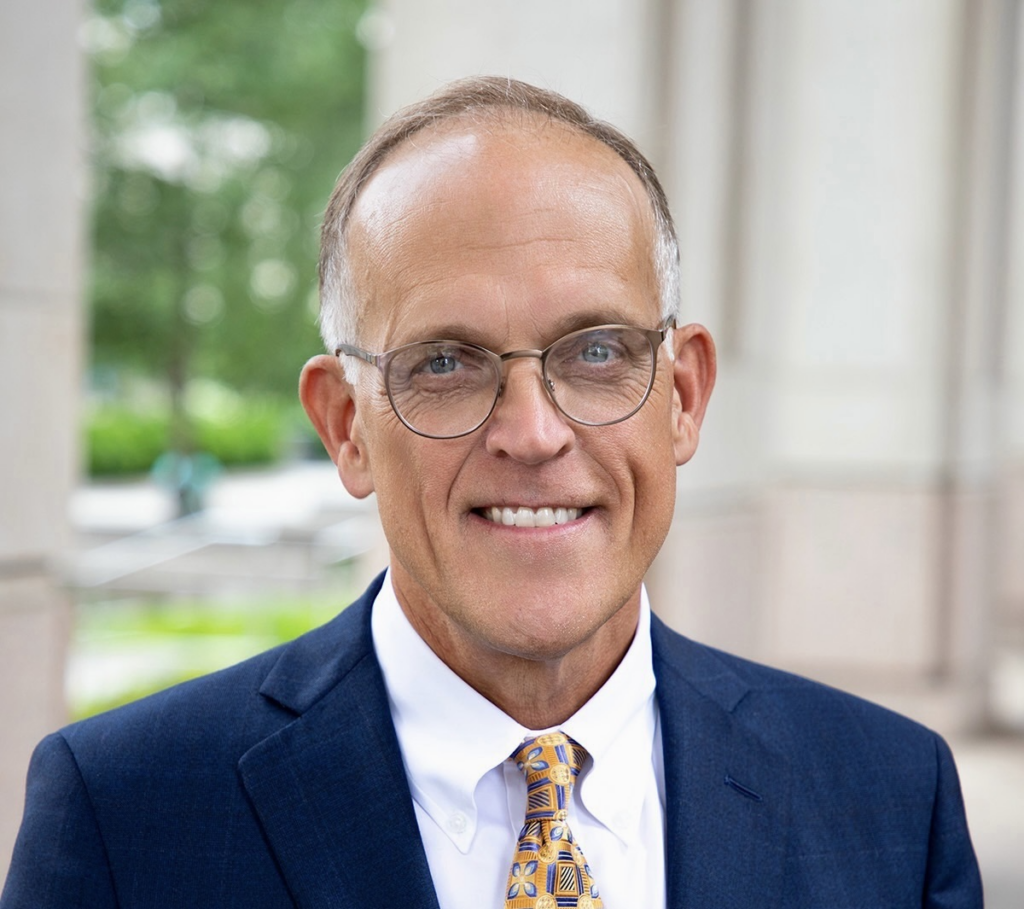
The Chris Lowery File
Title: Indiana Commissioner for Higher Education
Residence: Batesville
Education: Bachelor of Science in public affairs from Indiana University and a Master of Science in management from Indiana Wesleyan University
Career: Prior to his appointment to lead the Commission in 2022, Lowery was a senior vice president at Ivy Tech Community College. Before that, Lowery led public policy and engagement for Hillenbrand, Inc. and was an aide to former Gov. Robert Orr and then-Sen. Dan Quayle.
Family: Wife Jerilyn, daughter Jordan, son Jarrod and two granddaughters
Contact Kaitlin Lange on Twitter @kaitlin_lange or at [email protected].
Twitter @stateaffairsins
Facebook @stateaffairsin
Instagram @stateaffairsin
LinkedIn @stateaffairs
Header image: Indiana Commissioner for Higher Education Chris Lowery talks to a reporter in his office. (Credit: Kaitlin Lange)
4 things to know about Braun’s property tax proposal
Sen. Mike Braun, the Republican candidate for Indiana’s governor, released a plan for overhauling property taxes Friday morning that would impact millions of Hoosiers, Indiana schools and local governments. “Nothing is more important than ensuring Hoosiers can afford to live in their homes without being overburdened by rising property taxes driven by rapid inflation in …
Bureau of Motor Vehicles looks to add new rules to Indiana’s driving test
The Bureau of Motor Vehicles wants to amend Indiana’s driving skills test, putting “existing practice” into administrative rule. Indiana already fails drivers who speed, disobey traffic signals and don’t wear a seatbelt, among other violations. Yet the BMV is looking to make the state’s driving skills test more stringent. A proposed rule amendment looks to …
In Indianapolis, Harris says she’s fighting for America’s future
Vice President Kamala Harris, the presumptive Democratic presidential nominee, told a gathering of women of color in Indianapolis on Wednesday that she is fighting for America’s future. She contrasted her vision with another — one she said is “focused on the past.” “Across our nation, we are witnessing a full-on assault on hard-fought, hard-won freedoms …
Indiana Black Legislative Caucus endorses Harris, pledges future support
The Indiana Black Legislative Caucus unanimously voted Wednesday to endorse Vice President Kamala Harris’ presidential run and will look at ways to assist her candidacy, the caucus chair, state Rep. Earl Harris Jr., D-East Chicago, told State Affairs. The caucus is made up of 14 members of the Indiana General Assembly, all of whom are …
